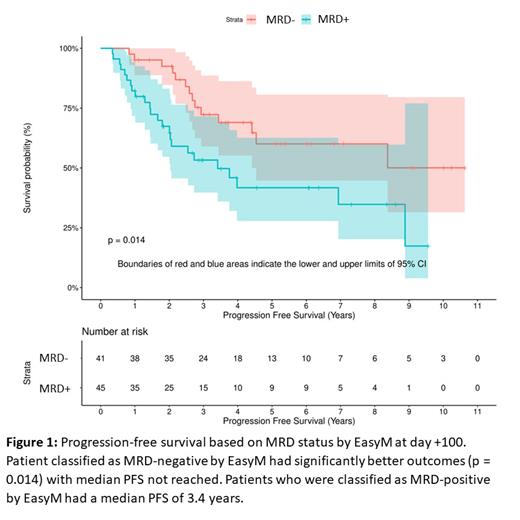Bone marrow (BM)-based measurable residual disease (MRD) has been established as one of the most important dynamic prognostic markers in multiple myeloma (MM). However, the necessity of bone marrow biopsies limits the feasibility of frequent MRD monitoring. Consequently, there is an urgent unmet need for peripheral blood-based MRD testing for serial monitoring of disease response to allow tailored therapy for patients achieving deep remissions.
Quantification of myeloma (M)-protein using mass spectrometry (MS) is a promising approach for peripheral blood-based MRD monitoring due to its exceptional analytical sensitivity. Prior studies have examined the use of MALDI-TOF-based methods, which relies on the mass distribution of intact immunoglobulins light chains and is approximately 1-log more sensitive than traditional testing. However, recent advances in MS technology have allowed determination and tracking of a “clonotypic” MS signature in the peripheral blood which is highly sensitive and patient-specific (Liyasova et al, CCR 2021). Prior reports have demonstrated the feasibility of this approach, but data supporting the association of blood-based clonotypic MS MRD with clinical outcomes is currently lacking.
Consequently, we performed a large retrospective analysis of patients enrolled in our institutional MM tissue bank to determine the association of clinical outcomes with clonotypic MS-based MRD testing (EasyM, Rapid Novor, Kitchener, ON). We identified patients in our institutional tissue bank who met the following criteria: 1) diagnosis of MM, 2) underwent autologous hematopoietic cell transplant (AHCT), 3) M-protein ≥0.2 g/dL by serum protein electrophoresis (SPEP) or >20 mg/dL (light chain) at diagnosis, 4) had no detectable M-protein by SPEP at day +100 and 5) had adequate samples for analysis collected at day +100 after AHCT. Patients were included regardless of M-protein isotype. Baseline and follow up samples were analyzed by Rapid Novor without access to the clinical outcomes. Percent residual EasyM at day +100, in respect to baseline EasyM, was used as the independent variable to predict Progression-free survival (PFS).
95 patients were included in the analysis. Median age was 63, 88% were White and 61% were male. 64% were IgG, 20% IgA and 16% were with light chain (LC) MM. 26%, 62% and 12% were R-ISS stage I, II and III, respectively. High-risk cytogenetics were present in 32%. 97% had received proteasome inhibitors, 89% received immunodulatory agents and 13% anti-CD38 antibodies prior to AHCT. The median year of transplant was 2018 (range: 2008 - 2022). 93% patients received AHCT as part of frontline therapy. 66% were in CR or better following AHCT. 95% received maintenance after AHCT.
9 patients had non-quantifiable EasyM at follow up and were excluded from derivation of the MRD definition. Of the remaining 86, patients with IgA/LC and IgG disease had significant different percent residual EasyM following AHCT (median: 0.19% vs. 1.00%, p < 0.001). A cutoff of 1.036% residual EasyM was derived for IgG and 0.048% residual EasyM for IgA/LC patients was determined to fit the PFS data best, and based on these cutoffs, 41 patients (47%) were MRD negative by EasyM. The incidence of MRD negativity between IgG and IgA/LC was similar (55% vs. 32%). MRD positivity by EasyM was a strong predictor of PFS following AHCT (Figure 1) (HR: 2.249, p = 0.017). The median PFS in MRD positive patients was 3.4 years versus not reached in MRD negative patients (log rank: p = 0.014) (Figure 1).
Our study is the first, to our knowledge, to demonstrate the clinical utility of peripheral blood-based clonotypic mass spectrometry to predict outcomes for patients with MM. Notably, our results suggest that different cutoffs should be employed for IgG and IgA/LC myeloma if drawn at day +100 after transplant. This is possibly due to the differing half-lives of these molecules. Significant additional questions remain, including the utility of ongoing monitoring at multiple time points and the optimal time post-AHCT to assess for MRD, especially in patients with IgG myeloma. Additionally, these findings require prospective validation in an independent cohort of patients to demonstrate wider applicability.
Disclosures
Slade:SecuraBio: Research Funding. Khaled:Rapid Novor Inc: Current Employment. McDonald:Rapid Novor Inc.: Current Employment. Liyasova:Rapid Novor Inc.: Current Employment, Patents & Royalties. Crees:BioLineRx, Ltd.: Other: Advisory Board, Research Funding. Schroeder:Marker Therapeutics: Membership on an entity's Board of Directors or advisory committees; Sorrento therapeutics: Membership on an entity's Board of Directors or advisory committees; Kura: Membership on an entity's Board of Directors or advisory committees; GSK: Consultancy; Novo nordisk: Consultancy; Incyte: Honoraria. Stockerl-Goldstein:Celgene: Consultancy. Yang:Rapid Novor Inc.: Current Employment, Current equity holder in private company, Membership on an entity's Board of Directors or advisory committees. Vij:Bristol Myers Squibb: Honoraria, Research Funding; Takeda: Honoraria, Research Funding; Sanofi: Honoraria, Research Funding; Legend: Honoraria; Janssen: Honoraria; Pfizer: Honoraria; Karyopharm: Honoraria; Harpoon: Honoraria.


This feature is available to Subscribers Only
Sign In or Create an Account Close Modal